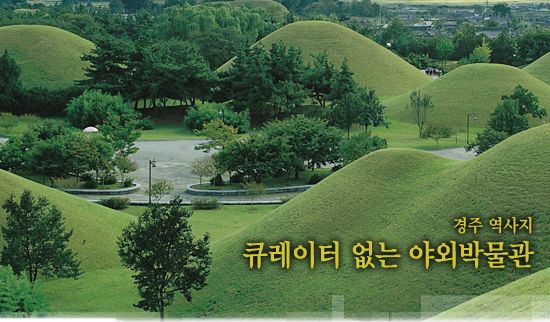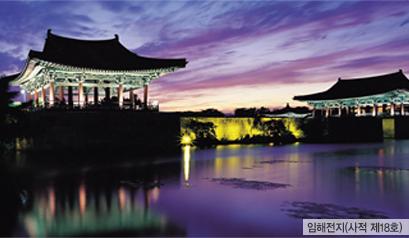유네스코는 불국사와 석굴암과는 별도로 남산과 그 주위에 산재한 52개 문화재를 한데 묶어 ‘경주역사지구’란 이름으로 2000년 12월 세계유산리스트에 올렸다. 이 숫자는 교토의 문화재보다도 많다. 교토는 불교사찰과 함께 신사神社가 주류를 이루는데 반해 경주는 불교와 왕실과 관련된 것뿐만 아니라 천문대와 정원, 놀이시설도 포함돼 있어 신라인들의 삶을 엿볼 수 있다. 실로 ‘한국의 폼페이’인 것이다.
경주역사지구는 크게 5개 지구로 구분된다. 불교미술의 보고인 남산 지구, 천년 왕조의 궁궐터인 월성 지구, 신라왕을 비롯한 고분군인 대능원 지구, 신라 불교의 정수인 황룡사 지구, 왕경王京 방어시설의 핵심인 산성 지구 등이 그것이다. 경주 남산은 정확하게 용장계곡으로 올라가는 고위산과 삼릉계곡에서 올라가는 금오산 등 2개의 산으로 구성되어 있으며, 토함산과 마찬가지로 주성분이 화강암인 돌산이다. 느긋한 일정으로 금오산 정상까지 오르면서 화강암 바위벽에 또는 그 바위를 다듬어 만들거나 새긴 불상을 하나둘 대하다 보면 불자가 아니라도 부처님의 자비를 온몸으로 느끼게 된다. 그건 또한 신라의 일반서민들의 마음이기도 했을 테니 신라인과 만나는 것과 다름없다.
[b]바위도 부처, 사람도 부처[/b]
 |
| |
10미터쯤 되는 바위벽은 수평으로 크게 금이 가 있지만 그 아래쪽을 대좌로 삼아 만든 삼릉계곡 선각육존불(시도유형문화재 제21호, 경북), 머리는 양각으로 몸은 바위에 음각으로 새겨 넣어 바위 전체를 부처의 몸으로 보고 있진 않았을까? 하는 궁금증을 자아내는 삼릉계곡 마애석가여래좌상(시도유형문화재 제158호), 금오신화를 쓴 매월당 김시습이 머문 곳이자, 한 60미터 높이의 거대한 바위산을 하층 기단으로 우뚝 서있는 남산 최고의 문화유산 용장사곡 삼층석탑(보물 제186호), 삼층석탑 아래의 암벽에 결가부좌의 자세를 취하되 광배와 대좌를 모두 갖추고 있는 용장사지 마애여래좌상(보물 제913호), 위엄과 자비가 넘치는 칠불암 마애석불(보물 제200호), 바위벽에 얕게 감실을 파고 이를 광배 삼아 보관을 머리에 이고 있는 보살상을 새겨 넣은 신선암 마애보살반가상(보물 제199호), 바위의 북면엔 석가여래좌상과 화려한 탑을 배치하여 신라 목탑의 형태를 보여주고 서면에는 마애여래와 비천상을 동면에는 승려 공양상과 수도승상이, 남면에는 삼존불과 감실을 두고 있는 탑곡 마애조상군(보물 제201호), 신라의 국방을 책임졌던 남산성(사적 제22호), 왕과 귀족들이 물길에 잔을 띄워 여유를 즐겼던 포석정지(사적 제1호) 등 남산은 등성이마다 석탑이요, 골마다 부처다.
[b]신라는 황금의 왕국[/b]
월성 지구에는 신라의 김씨의 시조 김알지의 탄생설화를 간직하고 있는 울창한 숲 계림, 신라왕조의 천년궁궐터인 월
성, 동양에서 가장 오래된 관측대로서 신라의 하늘과 시간을 살짝 보여줄 것만 같은 아름다운 몸매의 첨성대(국보 제31호), 왕실에 얼음을 공급하던 얼음 창고 석빙고(보물 제66호), 신라 통일기의 건축과 조경과 왕실의 여가생활 등을 더듬어 볼 수 있는 임해전지(사적 제18호) 등이 자리하고 있다.
시내 주택가 한가운데에는 천마총, 미추왕릉(사적 제175호), 황남대총 등 모두 23기의 능이 봉긋이 솟아 있으며 여기에서 출토된 금관과 각종 금제 장신구, 천마도, 유리잔, 각종 토기 등 당시의 생활상을 엿볼 수 있는 대능원 지구가 있다. 그 중에서도 백미는 천마총이다.
1973년 4월, 155호 고분의 발굴로 시작되어 6월에는 분묘 속에 감추어져 있던 금관이, 100일 후에는 금귀고리를 비롯하여 금모, 금띠, 요패 등이, 8월에는 자작나무 껍질 위에 질주하는 듯 비상하는 듯한 모습의 백마 그림이 각각 발견되어 이로 인해 이 고분이 천마총이란 이름을 갖게 됐다. 출토된 유품은 1만 점을 웃돈다.
황룡사 지구에는 한때 88m 높이의 웅장한 목탑이 서 있었음을 증명해주기라도 하듯 황룡사터에 거대한 심초석이 그대로 남아 있다. 비록 몽고의 침입으로 탑은 소실되었으나, 신라의 3대 보물 중 옥대를 제외한 두 가지 보물이 황룡사 9층 석탑과 장존육상이었다는 점에서 이 자리는 귀중한 문화유산이다. 그리고 지금은 3층만이 남아있지만, 높이 9.3m의 모전 석탑 형태로 탑의 동서남북 네 개의 문을 금강역사상이 단단히 지키고 있는 분황사석탑(국보 제30호) 등이 있다. 산성 지구에는 서기 400년 이전에 왕경을 방어하기 위해 쌓은 것으로 추정되는 명활산 지구가 있다. 신라인들의 축성술은 일본에까지 전래됐다고 알려졌다.
이렇듯 경주역사지구는 거대한 야외 박물관이다. 그렇다고 특별한 큐레이터가 있어 이 모두를 기획하여 전시하고 있는 것도 아니다. 하나하나가 제각기 알아서 그 자리에서 빛을 발하고 있는 것이다. 사실이 이러한데, 누가 경주 남산 주위에 산재한 다양한 문화재들을 보지 않고 경주를 보았다고 할 수 있으리오. 누가 뭐래도 경주역사지구야말로 신라 최고의 보물인 것이다.
[b]Gyeongju Historic Areas,
an Outdoor Museum without Curator[/b]
A collection of 52 cultural properties in Gyeongju was inscribed on the UNESCO World Heritage List in December 2000 under the name Gyeongju Historic Areas, separate from the ancient city''s other World Heritage site, Seokguram Grotto and Bulguksa Temple. Although Japan has a similar case of collective inscription, the Historic Monuments of Ancient Kyoto includes fewer cultural properties. Also, while the Kyoto site largely comprises Buddhist temples and Shinto shrines, the Gyeongju Historic Areas is composed of an astronomical observatory, a garden and entertainment facilities, and relics of Buddhism and the royal court, offering a glimpse into the life in the Silla Kingdom (B.C. 57-A.D. 935). Gyeongju is truly the Pompeii of Korea.
The Gyeongju Historic Areas is divided into five components: Mt. Namsan Belt, a treasure-house of Buddhist art; Wolseong Belt, the palace site of the 1,000-year-old Silla kingdom; Daeneungwon Belt, a group of massive ancient tumuli; Hwangnyongsa Belt, the essence of Silla Buddhism; and Sanseong Belt, defense facilities of the ancient capital. First, Mt. Namsan, home to many cultural properties, refers to the entire area connecting Mt. Gowisan and Mt. Geumosan, which are approached from Yongjang valley and Samneung valley respectively. Like Mt. Tohamsan, the seat of Bulguksa and Seokguram, Mt. Namsan is largely made up of granite as well. As one hikes to the mountain top, leisurely appreciating the Buddha images engraved on or fashioned out of granite, the mercy of the Buddha is almost palpable in the air, no matter what one''s religion. As the Silla people would have experienced the same feelings, a spiritual connection occurs with Koreans of the past.
[b]Buddha on the Rocks, Buddha in People [/b]
 |
| |
At Mt. Namsan, a stone pagoda is found on every ridge and a Buddha in every valley: two pairs of rock-carved Buddhist triads in Samneung valley, which have wisely turned a large horizontal crack on the rock surface into a sculptural element by taking it for a pedestal; the relief of seated Sakyamuni in Samneung valley, whose head and shoulders are rendered in relief while the rest of the body is depicted in very shallow lines, so that those who see it cannot help wondering if the sculptor regarded the whole rock as the Buddha''s body; the three-story stone pagoda atop Mt. Namsan, taking the 60-meter rocky mountain as its foundation, at the site of Yongjangsa Temple where Kim Si-seup (1435-1493) wrote the first known classical work of Korean fiction, Geumo Sinhwa (Myth of Mt. Geumosan); the Buddha image sitting in lotus posture with a halo and pedestal, carved on the rock face at Yongjangsa Temple site; the Buddha images on a rock pillar near Chilburam Hermitage, which exude dignity and mercy; the seated crowned Bodhisattva in the shallow niche-cum-halo on the rock surface near Sinseonam Hermitage; a group of Buddhist images portrayed on a large square rock in Tapgok valley--a seated Sakyamuni and a splendid pagoda giving an indication of Silla''s wooden pagoda style on the southern face, a Buddha and celestial maiden on the western face, monks offering prayers or in meditation on the eastern face, and a Buddha triad in a niche on the southern face; Namsanseong mountain fortress built to protect the Silla Kingdom; the site of Poseokjeong where the king and the nobility composed poems and floated wine cups along a winding water channel.
[b]Silla, the Kingdom of Gold[/b]
The historic monuments of Wolseong Belt include the lush forest Gyerim, the birthplace of Kim Al-ji, legendary ancestor of the Gyeongju Kim clan which ruled throughout most of the Silla Kingdom; Wolseong, the site of Silla
 |
| |
palaces; the beautifully shaped Cheomseongdae, the oldest observatory in the East and a window to the ancient
kingdom; Seokbinggo, the ice storage for the royal court; and the site of Imhaejeon, palace of the Crown Prince, hinting at Silla''s architectural style, landscaping and pastimes.
In the middle of a residential district in downtown Gyeongju is Daeneungwon Belt comprising 23 Silla tumuli belonging to the royal family and nobility. Such diverse relics as gold crowns, golden ornaments, glass cups and pottery have been excavated from the tombs, providing valuable insight into life at the time. Of the ancient tombs, Cheonmachong is definitely the finest.
Excavations of Cheonmachong (Tomb No. 155), started in April 1973, revealed over 10,000 cultural artefacts, including a gold crown, gold cap, gold belt and waist pendants. In August that year, a mudguard flap made of birch bark depicting a white horse flying into the sky was unearthed. Hence, the name of the tomb ?heonmachong,?which means ?eavenly Horse Tomb.?
Testifying to the existence of a magnificent wooden pagoda at Hwangnyongsa Temple, a large central pillar remains on the site today. Although the 88-meter-high pagoda was reduced to ashes during the Mongolian invasions of the 13th century, the site is still significant as the temple was home to two of the three precious treasures of Silla, the 9-story pagoda and the iron Buddha statue five meters high. In the vicinity of Hwangnyongsa Temple is another Silla temple, Bunhwangsa, with a 9.3-meter-high imitation brick pagoda whose doors in each direction are guarded by vajrapani. This pagoda is thought to have had as many as seven to nine stories, but only three stories remain. Lastly, Sanseong Belt includes a fortress surmised to have been built on Mt. Myeonghwalsan to protect the capital city before 400 A.D. The fortification technology of Silla is known to have been transmitted to Japan.
The Gyeongju Historic Areas is a large outdoor museum. Not organized by any curator, the ancient artefacts emanate the charm of antiquity as they are. Nobody can say they have seen Gyeongju properly without seeing the diverse cultural relics scattered in and around the ancient capital. Without a doubt, the Gyeongju Historic Areas comprises the most valuable treasures of Silla.
▶글_ 권삼윤 역사여행가, 세계문화유산 전문가 사진_ 한국관광공사
Text by Gwon Sam-yun, History Traveller & World Heritage Expert Photo by Korea Tourism Organization














